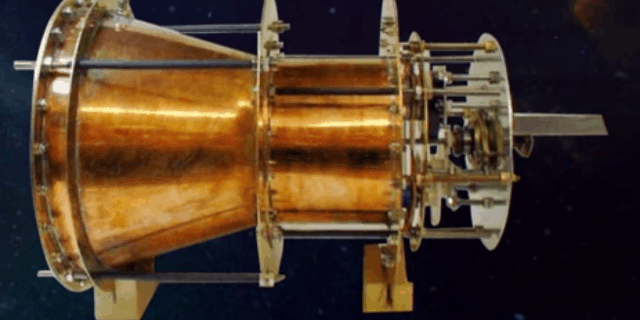The Science Behind the Impossible EM Drive

One of the most controversial stories in science right now is the EM Drive, a hypothetical new type of spacecraft engine that seems to break the laws of physics. While many scientists are highly skeptical the device even works, it's been tested multiple times, including by a team of NASA scientists, and some tests seem to indicate that it does work.
So what exactly is going on? What is the EM Drive exactly, and how could it be breaking the laws of physics? Is there another explanation? Probably. PBS Space Time explains:
The EM Drive was invented by Roger Shawyer around the turn of the century, and involves a large, tapered metal cylinder that's closed at both ends. Microwaves are generated inside the cylinder and bounce back and forth.
That's pretty much it, and yet somehow this device actually seems to produce a small amount of thrust. When a team of NASA scientists tested it, they found that it produced about 1 newton of thrust for every megawatt of power they pumped into it. This would make the EM Drive about as efficient as the ion drives already used by most long-range spacecraft.
[contentlinks align="left" textonly="false" numbered="false" headline="More%20on%20the%20EM%20Drive" customtitles="Space%20Engine%20Breaks%20Laws%20of%20Physics?%7CThe%20EmDrive%20Finally%20Will%20Undergo%20Peer%20Review%7CThe%20Impossible%20Drive%20Is%20Heading%20to%20Space" customimages="||" content="article.11042|article.20076|article.22678"]
But unlike an ion drive, the EM Drive uses no propellant. This means it violates a bunch of physical laws like the conservation of momentum. As Space Time puts it, it's a bit like trying to make a car go forward by sitting in the driver seat and pushing on the windshield.
The NASA researchers provide a number of possible explanations for this weirdness, like internal vibration or heat distortion, none of which involve breaking the laws of physics. And truth be told, one of those explanations is almost certainly correct. It's much more likely that the researchers are overlooking something than that much of our physics is wrong.
But if the EM Drive really does work, what's happening? That's a tougher question, but the answer may lie in an obscure interpretation of quantum mechanics called pilot wave theory. According to the researchers, if pilot wave theory is true, it may allow the EM Drive to push against the vacuum of space itself and generate thrust that way.
This explanation has its own set of problems, like the fact that we don't even know if pilot wave theory is true. Even if it were true, it may not even explain the EM Drive at all. But regardless of the possible explanations, if the EM Drive turns out to be a real effect, physics would become a lot more interesting.
Source: PBS Space Time
You Might Also Like

